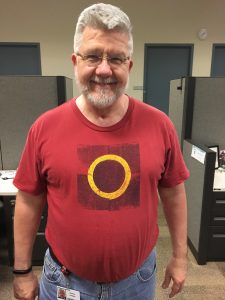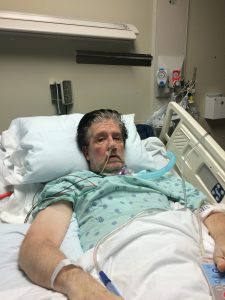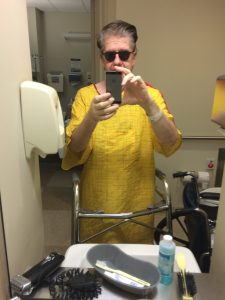
Jerry Conway was healthy and active before the antibiotic Cipro allegedly caused serious damage to his heart.
Meet Jerry Conway. A man who went from being able to bike 25 miles in a single stretch to barely being able to walk to his car. A man who went from making a triple digit salary to living out of his car for a period of time. A man who doctors told him was still alive after a fatal aortic dissection only because of the healthy lifestyle he maintained. An aortic dissection that may have been caused by the common antibiotic Cipro.
An aortic dissection is a serious condition caused by a tear in the inner lining of the aorta. The aorta is a major artery carrying blood out of the heart, according to Medline Plus Medical Encyclopedia.
As the tear extends along the wall, blood can flow in between the layers of the blood vessel wall (dissection). This can lead to a rupture of the aorta itself or decreased blood flow to other organs.
Cipro is the brand name of a prescription antibiotic medication used to treat common bacterial infections. It is one of the six most popular antibiotics in the United States, which all together are prescribed to more than 26 million people annually. It is used to treat bronchitis, pneumonia, and other more common illnesses, such as sinus, ear and urinary tract infections.
Cipro’s main ingredient, ciprofloxacin, belongs to a class of drugs called fluoroquinolones. As a fluoroquinolone treatment, Cipro affects collagen composition in the body, which makes up the majority of the lining of the aorta. Medical journals such as BMJ and JAMA have published studies linking the collagen degradation caused by fluoroquinolones to an increased risk of aortic aneurysms or dissections.
Cipro has had multiple Food and Drug Administration warnings since its market emergence in 1987. Most serious was a black box warning issued in 2008, requiring the manufacturers to include a warning on the drugs’ label concerning the risks of tendinitis and tendon rupture for users.
In 2016, the FDA revised that warning to say all fluoroquinolones, including Cipro, should only be used in patients who have no other treatment options for the common infections the drugs were approved to treat. This is due to their potential to cause debilitating and sometimes permanent side effects of the tendons, muscles, joints, nerves and central nervous system.
From infection to dissection
Before his medical trauma, Conway was a healthy and successful 58-year-old. In the business world, Conway was achieving financial and managerial success. He had earned a bachelor’s degree in marketing and management and a master’s of business administration in finance, and was working as a financial project manager.
In the physical world, Conway had made an intentional lifestyle change after watching both his parents fight a painful battle with cancer. Ultimately, both of them succumbed to the disease.
“In June 2009, after my mother passed away, I made a conscious effort to take very good care of myself. I realized that if something happened to me health-wise, I would have to go into a home because there was no one to take care of me,” Conway said.

Jerry was hospitalized for over a month after an emergency surgery where doctors re-harvested a vein from his leg to his heart.
So he started working out regularly and adhering to a strict Paleo diet. Conway changed out diet soda for water and added herbs and vitamins to his daily regimen. By the time of his heart problems, Conway was feeling fit, trim and healthy, like he “found the fountain of youth.” Later, doctors informed him that his overall health was one of the main reasons he survived the intense surgeries and hospitalization that followed.
But during this time Conway had also been fighting off chronic ear and sinus infections. Doctors had prescribed the antibiotic Cipro to help combat these infections – more than 20 full prescriptions in a 6-7 year period.
On Oct. 7, 2014, Conway felt debilitating pressure on his chest and checked himself into the emergency room for fear of a heart attack. That’s when the tear in his aorta was discovered.
Conway had to have 11 hours of surgery during which approximately 8 inches of a vein in his left thigh was taken out to re-harvest his heart (he is still unable to walk normally on his left leg). During the procedure, stents were place in his heart and he suffered a stroke. He had two full transfusions, as the first transfusion his heart rejected. The hospital asked him if he wanted to have last rites performed and assisted him in making final calls to his family.
“I wasn’t sure what was going to happen to me, but I knew at some point that I could very well die,” Conway said. “At that point, you’re either a fighter or you’re not. I made my peace with God and prayed that He could spare my life.”
Fighting for his life
Conway proved he is a fighter. He had a will to live and a support system in his sister Diane, who he called his angel. He says he also had great examples from his parents, who bravely fought their cancers and refused to give in to the diagnosis. (His father lived two years longer than the doctors said he would.)
“I tell people it’s in the DNA after seeing my own parents fight through their medical issues. It was a path I chose to maintain,” Conway said. “I hope to give inspiration to others to never, ever give up no matter what the odds may be or what the doctors may say.”
Despite the odds, Conway made it through the surgery and a month-long, medically induced coma.
“When I did awaken, I felt like I had been run over by a dozen 18-wheelers over and over again,” Conway said.
While still recovering in the hospital, he had to be fed through a tube in the stomach and breathe through a tracheotomy.
“There is no greater punishment than having a tracheotomy,” Conway recalls. “I could not eat with it nor could I talk with it at first. Having someone come to my room to suction it for me was feeling like I was gasping for my last breath. I would not wish that feeling on anyone.”
Conway was finally able to go home the day before Thanksgiving. Four days later, he was back in the hospital due to a windpipe collapse. He later learned the collapse was caused by scar tissue from the first tracheotomy, which had to be removed via laser. Ironically, Conway had to have another trach after the second surgery. He was sent to a rehab center for the full month of January and didn’t go home until Jan. 30, 2015.
“I came into the hospital in October weighing 207 pounds with thick muscular legs and a physique of someone who took care of himself,” Conway said. “When I finally left at the end of January, I was a shell of myself weighing 163 pounds.”

Jerry has worked to regain his strength following two massive surgeries to repair damage allegedly caused by Cipro. Jerry said his doctors prescribed him the popular antibiotic 20 times in a six- to seven-year period before a tear was discovered in his aorta.
By the time he left, his arm veins were useless for blood work. The residue from the trachs and scar tissue made it hard to breathe. Because of the vein that was taken out of his left leg, there is still tightness and pain there, which in turn affects his lower back, collarbone and sciatica. Walking and sleeping are difficult.
Conway is currently getting lymphatic massages in his left foot, out of pocket. While they don’t make any progress, the massages prevent him from regressing. He lives in constant pain and refuses to take heavy pain medication, as he has seen loved ones become reliant or addicted to the meds and the devastation it causes.
The medical bills and hospital stays caused Conway to lose his job and only means to pay bills like utilities and rent. In February 2015, Conway lost his apartment and had to live out of his car. He spent a night in county jail after being arrested for panhandling and was involved in a car accident. On Dec. 2, 2015, he had to file bankruptcy.
Rebuilding what was lost
Conway now works for a bank, lives in a low-grade motel in Dallas and has almost all of his worldly possessions in two storage units. But this life of pain and living hand-to-mouth is not what he desires.
“I don’t want pity; one day I just hope to have a normal life. I want to be able to work less, go to the gym more and take care of myself,” Conway said.
One of the things that frustrates him most is he feels this chain of events was caused by something that wasn’t his fault – the collagen-degrading Cipro.
“If I had an accident while driving drunk, well I deserved it; I broke the law. If I was pumping gas and lit a match, that would be contributory negligence. But I didn’t do any of this stuff. I took really good care of myself,” Conway says.
He notes that he has retained the National Injury Attorneys, LLC and Baron & Budd, P.C. to pursue his Cipro lawsuit because he wants to prevent someone else from being in this situation.
“I’m not looking for a money grab or to point the dirty stick,” he said. “I just don’t want anyone to go through what I went through.”
Note: The information provided in this article is based on reports from publicly available sources, including news outlets, police reports, and eyewitness accounts. National Injury Help has not independently verified all details of the reported incident. If you find any inaccurate or outdated information, please contact us, and we will review and update the content as appropriate. The photo used in this post is for illustrative purposes only and does not depict the actual scene of the incident.
Disclaimer: The content of this article is intended for informational purposes only and does not constitute legal advice or establish an attorney-client relationship with National Injury Help. For legal assistance specific to your case, we encourage you to contact a qualified attorney.
Free Case Evaluation
Contact Us today for a FREE, Immediate Case Evaluation
Contact Us today for a FREE, Immediate Case Evaluation
Categories
Recent post
- Scottsdale, AZ – Choque múltiple en la Ruta 101 deja heridas graves
- Phoenix, AZ – Hombre muere tras ser atropellado en accidente peatonal en Buckeye Rd
- Scottsdale, AZ – Multi-Vehicle Crash on Loop 101 Leaves Two Seriously Hurt
- Phoenix, AZ – Man Fatally Struck in Pedestrian Crash on Buckeye Rd
- Los Beneficios de Mantener un Estilo de Vida Saludable






